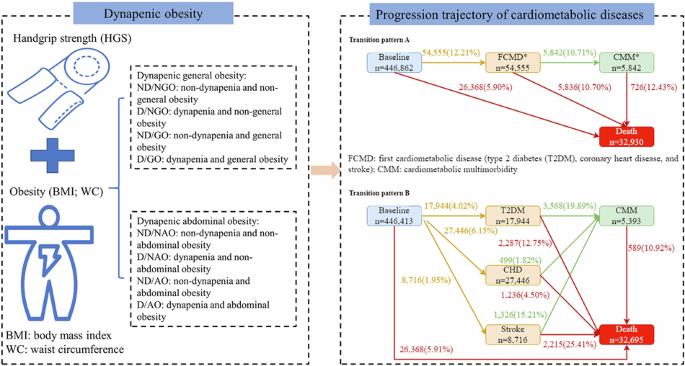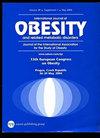动态肥胖与心脏代谢疾病的发病率和进展轨迹相关:一项前瞻性队列研究
IF 3.8
2区 医学
Q1 ENDOCRINOLOGY & METABOLISM
引用次数: 0
摘要
背景:动态肥胖对心脏代谢多病(CMM)进展的影响尚不清楚。本研究旨在探讨运动性肥胖与心血管代谢疾病(CMD)进展的关系,以及c反应蛋白(CRP)和血浆粥样硬化指数(AIP)的介导作用。方法:该研究包括446,862名英国生物银行参与者。CMM被定义为两种或三种CMDs的共存,包括2型糖尿病(T2DM)、冠心病(CHD)和脑卒中。通过握力(HGS)、体重指数(BMI)和腰围(WC)进行评价,将动力型肥胖分为一般动力型肥胖和腹部动力型肥胖。采用多状态模型评价动态肥胖对CMD进展的影响。采用反事实中介分析探讨CRP和AIP的中介作用。结果:在中位13.67年的随访中,54,555名参与者发展为CMD, 5842名参与者发展为CMM, 32,930名参与者死亡。与非动力性肥胖和非一般性肥胖(ND/NGO)相比,动力性肥胖和一般性肥胖(D/GO)的首次CMD (FCMD)、CMM和死亡的hr (95% CI)分别为2.75(2.61,2.90)、4.61(4.05,5.24)和1.68(1.56,1.80)。在动力型腹部肥胖中也观察到类似的结果。与ND/NGO相比,CRP和AIP介导的D/GO与手足口病风险的关联比例分别为19.58% (95% CI: 18.66%, 20.18%)和18.99% (95% CI: 18.12%, 19.62%),低于运动障碍和腹部肥胖(D/AO)与手足口病风险的关联比例(CRP: 30.38%, 19.58%;AIP: 31.40% vs. 18.99%)。此外,与口蹄疫相比,CRP和AIP在运动性肥胖和CMM之间的关联中所占的比例更大。结论:本研究表明,在CMD的纵向进展过程中,与动态肥胖相关的影响存在差异。CRP和AIP可能在这种关联中起部分作用。本文章由计算机程序翻译,如有差异,请以英文原文为准。

Dynapenic obesity associated with incidence and progression trajectory of cardiometabolic diseases: a prospective cohort study
The impact of dynapenic obesity on the progression of cardiometabolic multimorbidity (CMM) remains poorly understood. This study aimed to explore the association between dynapenic obesity and cardiometabolic diseases (CMD) progression, as well as the mediating roles of C-reactive protein (CRP) and the atherogenic index of plasma (AIP). The study included 446,862 UK Biobank participants. CMM was defined as the coexistence of two or three CMDs, including type 2 diabetes (T2DM), coronary heart disease (CHD) and stroke. Dynapenic obesity was classified into dynapenic general obesity and dynapenic abdominal obesity, assessed by handgrip strength (HGS), body mass index (BMI), and waist circumference (WC). A multi-state model was employed to evaluate the influence of dynapenic obesity on CMD progression. Counterfactual mediation analyses were conducted to investigate the mediating role of CRP and AIP. Over a median 13.67-years follow-up, 54,555 participants developed CMD, 5842 developed CMM, and 32,930 died. Compared with non-dynapenia and non-general obesity (ND/NGO), the HRs (95% CI) of first CMD (FCMD), CMM, and death for dynapenia and general obesity (D/GO) were 2.75 (2.61,2.90), 4.61 (4.05,5.24), and 1.68 (1.56,1.80), respectively. Similar results were observed for dynapenic abdominal obesity. Compared with ND/NGO, the proportions of CRP and AIP mediated associations of D/GO with FCMD risk were 19.58% (95% CI: 18.66%, 20.18%) and 18.99% (95% CI: 18.12%, 19.62%), respectively, which were lower than the proportions mediated in the associations of dynapenia and abdominal obesity (D/AO) with FCMD (CRP: 30.38% vs. 19.58%; AIP: 31.40% vs. 18.99%). Furthermore, CRP and AIP accounted for a greater proportion of the association between dynapenic obesity and CMM than FCMD. This study indicated that there are differential effects associated with dynapenic obesity during the longitudinal progression of CMD. CRP and AIP may play a partial role in mediating this association.
求助全文
通过发布文献求助,成功后即可免费获取论文全文。
去求助
来源期刊

International Journal of Obesity
医学-内分泌学与代谢
CiteScore
10.00
自引率
2.00%
发文量
221
审稿时长
3 months
期刊介绍:
The International Journal of Obesity is a multi-disciplinary forum for research describing basic, clinical and applied studies in biochemistry, physiology, genetics and nutrition, molecular, metabolic, psychological and epidemiological aspects of obesity and related disorders.
We publish a range of content types including original research articles, technical reports, reviews, correspondence and brief communications that elaborate on significant advances in the field and cover topical issues.
 求助内容:
求助内容: 应助结果提醒方式:
应助结果提醒方式:


